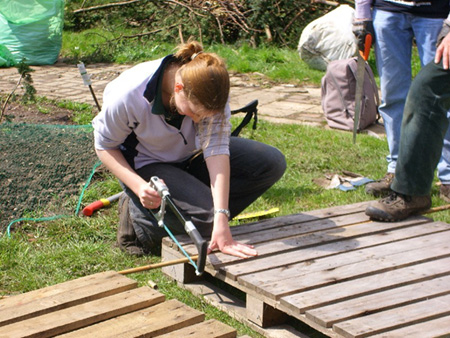CROW (Conserve Reading on Wednesdays)
Wednesday, 23rd April 2008
Caversham Court ~ Creating bumblebee bank

The bumblebee bank was to consist of an area planted with nectar rich flowers to attract and sustain bees, with some artificial nesting sites. Before starting planting, the ground had to be cleared - it was covered with ivy and grass - and the two slow-worms and a newt disturbed in the process relocated.

Although a wild flower mix might have been preferred it is not essential, and we used garden varieties of plants such as foxglove and dianthus (possibly more acceptable to the allotment holders with plots near to the site). Note: Wild flowers are to be planted in adjacent areas later in the year.


Bumblebees will nest in places such as a disused mouse's nest, using the existing nest material to form their own nest. Here we've dug a hole and filled it with suitable material before covering with a roofing tile. As the success rate of artificial bumblebee homes is low, around 7%, we are not very hopeful.

We also created homes for other insects. Old canes cut to about 30cm. lengths and bound together can provided excellent homes for solitary bees as well as hibernating lacewings and ladybirds, and are an inexpensive alternative to what is available commercially.


With hindsight, string was not the best material with which to bind the canes and wire would, with the aid of pliers, have bound them more tightly and been longer lived.


The insect hotel, another use for those unwanted pallets and in trendy blue seems to be just what Reading's contemporary home dweller is looking for.



Hay, straw, pine cones, old flowers pots and more, everything those of a more discerning disposition could wish for.

"What a capital little house this is! So compact! So well planned! Everything here and everything in its place!"
The Rat from Kenneth Graham's The Wind in the Willows.
(Rats are probably the one member of the wildlife community we're not hoping the encourage!)

The team: Camilla (student, Reading University, who provided information on the construction of bumblebee banks), Alan, Lawrence, Mike and John. Not in the picture: Judith who was with us for the morning and Emily (RBC) who as well as helping, organised the task and provided the materials and plants, and even found time to take the photo's for which we send our thanks.